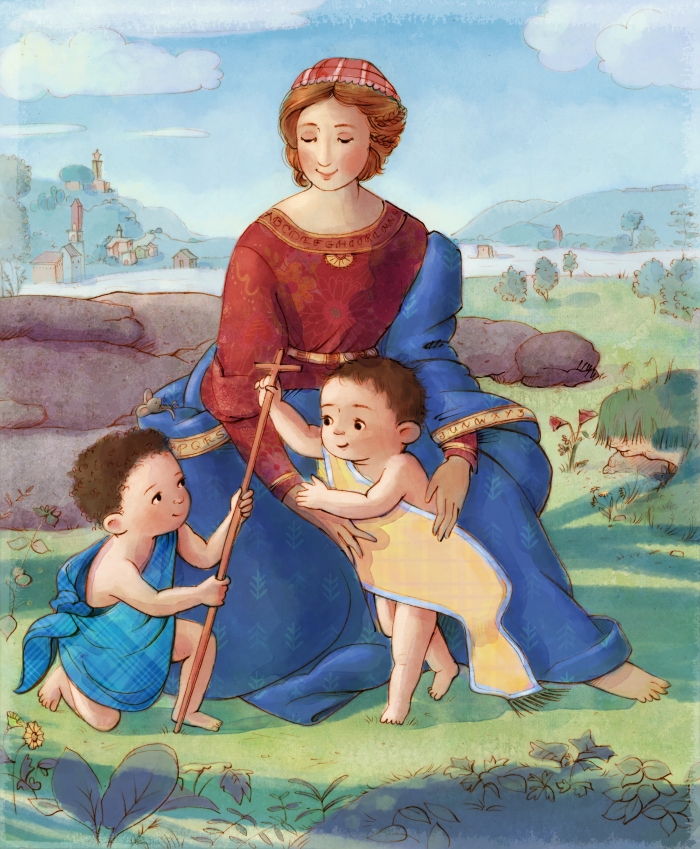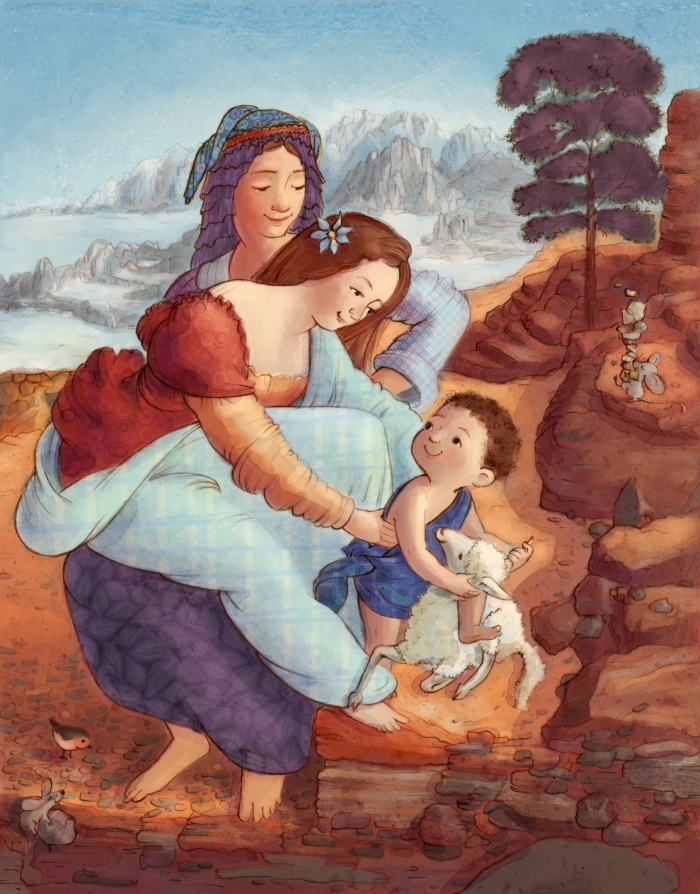

My Changes:
Aside from ramping up the color saturation, stylizing the characters, adding in more modest apparel, and changing some value structure I didn’t change much. As with da Vinci, I tried out a few different color choices, but in the end I preferred what Rafael had given me. He naturally used lighter, brighter colors in his work than previous artists, which lends itself nicely to children’s illustrations. (Hopefully that wouldn’t offend him!)
Things I thought/Questions I asked:
I didn’t intend to do three religious scenes in a row, but here you go! (We’re back to mythology mixed in real life next week.) It’s been interesting to see the various ways each artist has depicted these scenes, especially the way they added in settings they were familiar with — like Bosch’s windmill, white-skinned babies, and landscapes you probably wouldn’t see in Jerusalem. Today we value accuracy when creating something historical, so it’s interesting to note that wasn’t always a point of emphasis.
Speaking of religious scenes, I read that Rafael likely painted a large number of Madonna and child paintings because they made good wedding presents! I also discovered that Rafael’s later renditions featured Mary in more relaxed, natural poses.
As far as this scene goes, I would love to visit the village behind Mary, Jesus, and John. Rafael paints his in an almost mystical way, like something in a fairy tale. And I love how gently Mary holds Jesus. Did they meet up with John for a playdate? Mary’s hands show how much she loves him, but her face has a distant look like she’s thinking about something else—which, as a mom I understand!
What I noticed or learned from Rafael’s techniques:
Rafael fully understands shapes and form and uses them to his advantage. His buildings almost feel rendered in a modern way. I love his color harmony and how soft he makes skin look (like da Vinci). His value and composition are also wonderful.

My Changes:
I have to admit I initially thought I had an easier painting this week since there are only three main characters (plus the lamb). In reality, this painting may have taken longer than the others, in large part because I oscillated between staying truer to the original versus adding in a more modern interpretive spin. Having a better plan for what I was trying to say in the beginning would have helped! In the end, I like it well enough but I don’t love it. In my experimenting, I put Jesus in a diaper, then a striped onesie, and eventually into his current wrap to preserve the historical nature of the piece. (As mentioned previously, it’s not easy to find children’s clothing from the 1500’s!) I liked the onesie, but felt that to make it work I then would have needed to change Mary’s and St. Anne’s clothing to fit the theme—hence why I could have used better planning!
Other experimenting included turning Mary’s dress a muted fuschia with hearts and her sleeves a bright yellow with pink polka dots. I even threw in faint hearts to the sky and rocks, and turned St. Anne into a spirit. As you can see, in the end I preferred the warmer color palette, but kept in more modern clothing patterns. If you look between da Vinci’s original and this painting, you’ll notice additional changes!
I’ll admit I felt intimidated doing a da Vinci. His work feels so sophisticated in comparison to my more playful style! Since he eliminates line and his edges are so soft it took some figuring out how to translate it into my style. I tried hard to incorporate his lovely expressions into my work but had to ensure it wasn’t too realistic to fit what I usually do.
Things I thought/Questions I asked:
What a beautiful scene! Like La Primavera, it feels magical—in part because St. Anne is a little larger than life. In the original, it’s not clear whether she’s resting her arm on the rocks in back and I opted to keep it that way. As I painted, I imagined the crash of ocean waves, the spray of ocean, the scent of salt, the rustle of leaves waving in the breeze. I love that Jesus is playing with a lamb and could feel its soft wool and warm breath. I tried hard to make Jesus’s hands appear gentle holding its ear.
I love the tender expressions on Mary, St. Anne, and Jesus as they look at each other. St. Anne’s headdress is rather unique, and I’m afraid I didn’t quite capture the delicate gracefulness in the original.
My goal is always to finish the linework before scanning and painting everything, but every time I realize there’s always more detail to add in. In this case, it was the mountains in back and some of the rocky structure up front.
What I noticed or learned from Da Vinci’s techniques:
I realized what makes Da Vinci unique is his softness, graceful lines, and unique expressions. He’s so good at the human form and fabric folds, and he adds quite a hefty load of detail to his deceptively simple-looking backgrounds. What I’ve learned so far from these master copies is how backgrounds and details, though not the part most of us focus on initially, complete the piece as a whole.

My Changes:
This is my first encounter with this wonderful painting—and actually it was a follower’s rendition that introduced me to it. (Which is what you'll find on the Original Masterpieces page; Bosch’s original can be found here.) I opted to only paint the center panel and to turn it into a children’s nativity scene — quite an elaborate one! — with the kids offering Jesus gifts of their own choosing. I asked my oldest son what he would have given, and he said probably a stuffed penguin . . . except that, after thinking it over, he would have been too in love with the penguin to actually give it up!
I didn’t like how Bosch painted Jesus and revised. I considered turning him into a doll to look like the original, but decided I preferred a real toddler (yes, in a footed sleeper) who was more interested in reaching toward something off-scene.
Because I started out using the follower’s rendition, I kept in some of their compositional and background element decisions, most especially the zoomed-in house. I also removed Bosch’s people on the roof and climbing the tree (in large part because that’s what the follower had done!). As usual, I tweaked the colors to be more kid-appealing and simplified many background details and house elements. I toyed around with different times of day (especially sunset and nighttime), but felt that a cool blue background ensured that our focus stay on the kids.
Things I thought/Questions I asked:
There are so many stories scattered around all the panels of the original and on the kings’s clothing, some of them related to Christ’s life, others completely not. If you look closely, you’ll find a wolf attacking the man in the right panel, a man warming himself by a small fire in the left, and a windmill in the background of the center panel. (Having lived in the Netherlands and Belgium for a time, I appreciated that detail and made sure to include one in mine!)
It would be wonderful to explore the town Bosch based this off of — it’s beautiful! As is often the case, I felt overwhelmed by the details as I sketched and had to be selective about what I most wanted to include given the amount of time I had to complete. (Each added detail adds more work!)
I really like the king from Africa and the servant girl he brought along. Since the crown she’s holding isn’t fully visible, and since I wanted her to get more spotlight, I moved her up a bit and had her bring a gift too. I then found an ancient African crown online from which I based the crown beside her.
What I most want to know is why Bosch put Jesus in such a dilapidated home! If Joseph was a carpenter, he would surely know how to keep it in tiptop shape? And why does Mary look so solemn?
What I noticed or learned from Bosch’s techniques:
I’m so impressed at Bosch’s desire and willingness to include so much in this painting. He is masterful at storytelling, particularly in the backstory elements. (You’ll find even more if you find a photo of the exterior when the panels are closed.) And within each detail are lots of small details. It must have taken him a very long time to complete this painting! Bosch’s attention to detail helped me care about the cracks in the building, the places where the dried mud and wood are wearing down, the slivers of wood in all the poles, the thatched roof, at the variances in color and texture in the house, and at the weeds growing between the bricks in the fence.

When I was little, Mom and I often looked through a beautiful book of Masterpieces. I asked lots of questions about these people painted in time: How were we the same? How were we different? If you are also a fan of masterpieces, children’s book art, and searching for mice, I invite you to follow along!
All images © Angela C. Hawkins


Love a MousterWork print? They will be available in my Etsy shop. Don’t see the one you want? Email me and I’ll add it in.